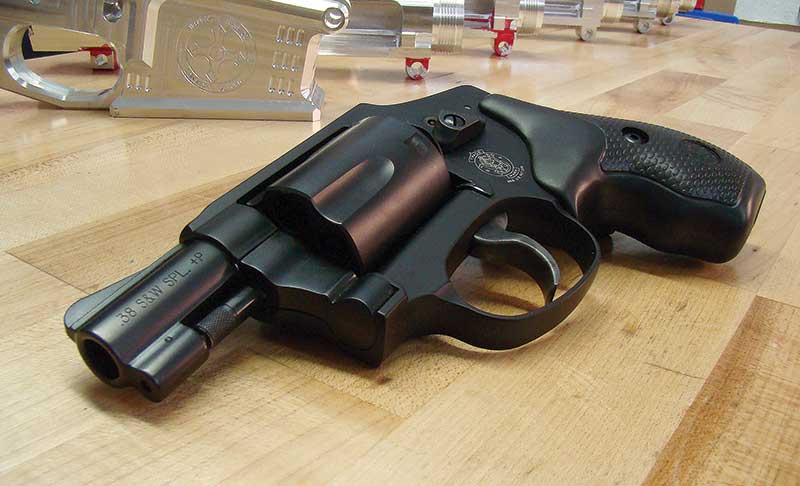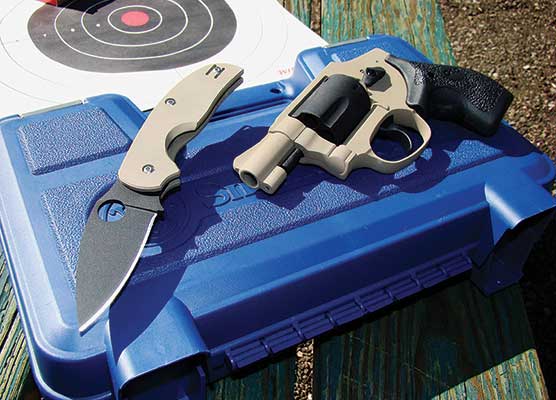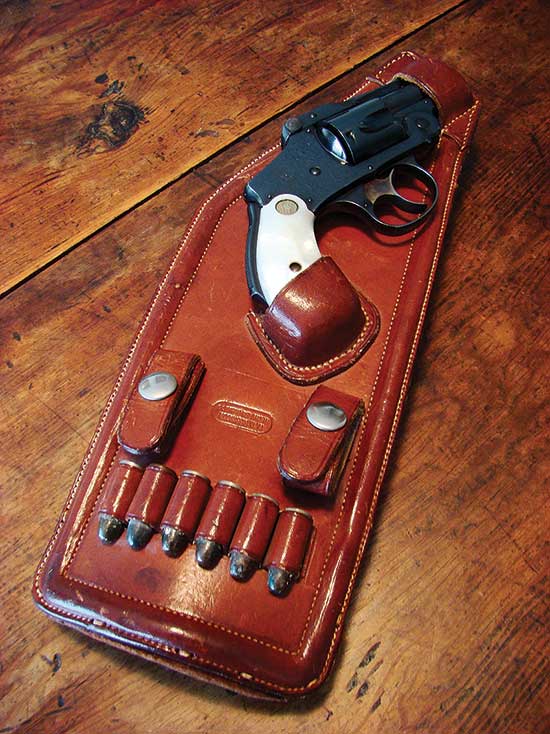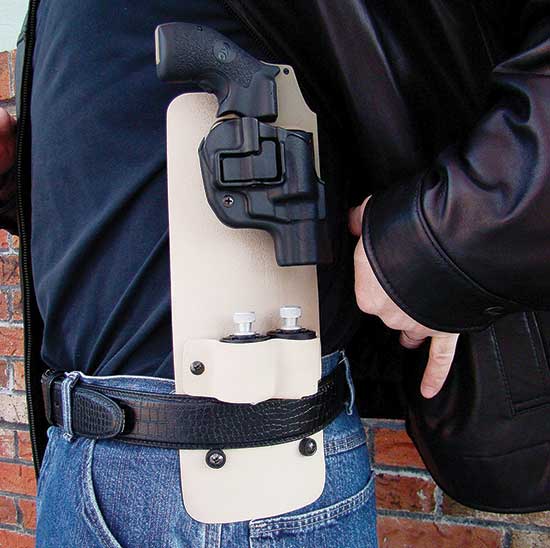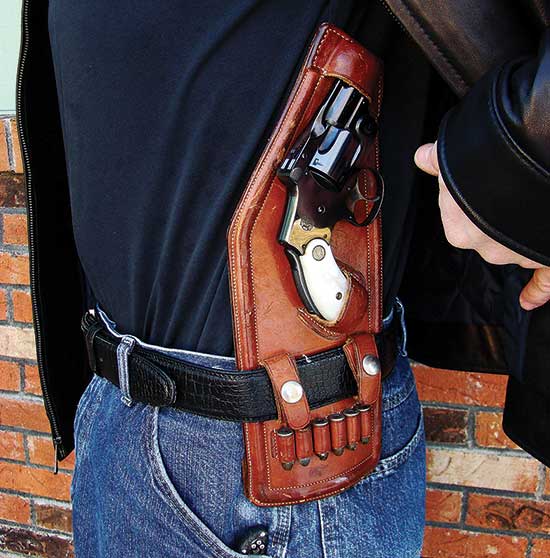Origins Of The New S&W Centennial Revolver
Col. Rex Applegate's Shoot-Out
Leads To A Revolver's Redesign
Col. Rex Applegate
“In 1947, after retiring from the regular army and moving to Mexico City, I formed a Mexican sales company for representation of American firearms and allied lines. During this period I carried a Fourth Model .38 SSmith & Wesson Hammerless with a 2” barrel, either in my pocket, or when in southern Mexico, in the hotter tropical climate, in a Myers special belt-attached, upside-down holster that was a very practical system, particularly when wearing an open bottom shirt as was customarily worn.
Just prior to one of my regular trips to the states around 1950, I had been in southern Mexico, near the Guatemalan border, in the area of Salina Cruz in the company of a Mexican Army officer. On this particular evening the officer and I encountered a very drunk, machete-wielding Indian who seemed bent upon decapitating us both. The officer carried his .45 Automatic in a US Army holster. While he was frantically trying to get it into action, I was successful in drawing my Safety Hammerless from the Myers holster, from under my sport shirt and dropped the machete wielding Indian after putting five slugs into his torso. He finally fell to the ground about five feet from me, just as I was getting ready to throw the empty gun at him. Due to the Mexican army connection, there were no repercussions.
I mentioned this incident to W.H.B. Smith when I next met him in New York, prior to our trip to the S&W plant, and complained about the lack of stopping power. We both began wondering why it was not possible, and advisable, for S&W to consider the production of a model similar to the Safety Hammerless, using the Chief Special frame in the more potent .38 Special caliber. We discussed this at some length with Carl Hellstrom [then president of Smith and Wesson].
On my next trip to the plant in the fall of 1951, Carl Helstrom presented to me a prototype model of one of the first Centennials. This is one of my most prized firearms and one which I will always treasure. I cannot help but think that, especially due to the urging of W.H.B. Smith and perhaps myself, that we were at least partially responsible for convincing Hellstrom to produce the Centennial Model.”
– Col. Rex Applegate, June 1990
The above passage is an excerpt from an unpublished work called The Guns of Famous Shooters written by the late Col. Rex Applegate. Intended to document the stories behind the most significant guns in his extraordinary personal collection, it also provides great insight into the genesis of one of the most popular personal defense guns ever produced, the S&W Centennial Model.
When I had the privilege of working with Col. Applegate in the late 1990’s, he shared this story with me and showed me the original S&W Safety Hammerless he used in the incident. He also showed me the “Myers” holster referenced in the passage and explained why it was one of his all-time favorite carry rigs. In another letter included in The Guns of Famous Shooters, dated January 1992, he explains, “When operating in warmer areas such as coastal or southern Mexico and in central Mexico, I used a special belt-suspended upside down holster (left side) that enabled me, with either hand, to draw quickly and unnoticed from the gun-butt down position when wearing an open bottom sport shirt.”
As both a fan and a student of unique concealed-carry rigs, I was fascinated with the Colonel’s Myers rig and always wondered why the design had never gained broader acceptance or made it into the market. I also knew the “lemon squeezer” .38 (so called because it possessed a grip safety) that he allowed me to examine was undeniably a significant piece of firearms history.
The Colonel’s Guns
After the Colonel passed away in 1998, the S&W Safety Hammerless and Col. Applegate’s Fitz Special .45 were purchased from his estate by my then-employer, Peder Lund, of Paladin Press. Lund maintained them in his collection for several years before deciding to sell them. I immediately jumped at the offer, even though I was unsure I could actually muster the asking price. After several months passed without a defined price, Peder came into my office with both guns in a plastic bag and handed them to me.
He stated that “I couldn’t think of anyone the Colonel would rather have own these guns. If you keep them, they’re yours. If you sell them during my lifetime, you owe me part of the sale.” Needless to say, that was one of the greatest honors I’ve ever received, and those two guns are the most treasured pieces in my collection.
Although I still get a thrill every time I pull them out of the safe and handle them, it always seemed a shame that guns that were bred explicitly for use as personal-defense weapons were relegated to “safe-queen” status. That got me thinking. Since the S&W Hammerless was in fact the inspiration for the Centennial model, what if I took that inspiration a bit further and created a modern expression of the Colonel’s Mexican carry rig? “Genius” may be a bit of an overstatement, but the idea was too cool to pass up.
Got Gun?
The first step in the process was to secure a S&W Centennial, the Model 442. Out of the box, this 5-shot J-Frame revolver boasted a factory matte black finish and black synthetic grips. For a stock carry gun, this combination was perfectly serviceable; but for this project, I wanted better. My first step was to take the gun to my friend Oliver Mazurkiewicz, owner and proprietor of Iron Ridge Arms in Longmont, Colorado. Iron Ridge is one of the premier suppliers of Class II and Class III firearms in the Rocky Mountain region. In support of these services, Iron Ridge has also become a leading source of aftermarket firearm finishes and coatings.
After talking with Oliver, I decided on a two-tone black-and-tan finish. For the frame I chose a coyote tan Cerakote ceramic finish. For the cylinder and trigger group, I opted for a black Teflon coating ofering both durable protection and enhanced lubricity of the moving parts. I left the gun — as well as a companion Spyderco Sage 2 folding knife — in Oliver’s capable hands and turned my attention to the other requirements of the project.
Get A Grip
Col. Applegate’s greatest contribution to the field of close combat was his work on handgun point shooting. The core elements of his method were based on an in-depth understanding of the physiological effects of life-threatening stress, most notably the loss of near-vision acuity and the tendency to naturally focus on the threat trying to kill you. Although the Colonel was very traditional in many ways, he also was amazingly progressive when it came to useful advances in gun technology — like laser sights. Since lasers put the sight picture on the target, where you will naturally be focused under stress, they are an outstanding tool for combative shooting. Crimson Trace were very intrigued with my project and were kind enough to provide samples of all three styles of J-frame LaserGrips they produce.
The Holster Platform
Next I turned my attention to the carry platform for the Applegate-inspired Centennial, which proved to be much more of a DIY project than the gun itself. I remembered Col. Applegate had mentioned “wearing out” several of the original carry rigs because the humid climate in Mexico quickly took a toll on the leather. With that in mind, I started with a BlackHawk J-frame SERPA holster. This popular injection-molded holster features the SERPA retention system, which automatically provides positive retention when the gun is inserted.
Since no commercial platforms for the Colonel’s style of carry are available, I decided to “roll my own” by heat-forming a panel of tan Kydex around a rolled carpet. With a little experimentation, I got the contour just right so it would tuck tightly against my pelvis when inserted under a belt. To simplify the design and make donning and doffing of the platform easier, I skipped the traditional belt loops and installed two “frogs” made from Chicago screws and rubber washers. And, while the Colonel’s original platform carried extra ammo in classic cartridge loops, I took a quantum leap forward and molded a Kydex double speedloader pouch that also acts as a shelf to support the platform’s weight.
Putting It All Together
To put it simply, the work Iron Oak did on the 442 turned out beautifully. The frame is a handsome matte-finished coyote tan, contrasted by the deep black of the cylinder, trigger, ejector rod and cylinder latch. The companion Spyderco knife I chose for the project received identical treatment, with tan Cerakote on the titanium handle and black Teflon on the blade. Aesthetically, both were perfect.
With all the component parts complete, I couldn’t wait to put them all together and “test-drive” the whole package. I first practiced drawing from the rig to get comfortable with it. Initially, I mounted the SERPA holster in a butt-down position to replicate the original; however, I found drawing from this position required a very precise angle and the gun would sometimes bind in the holster. Re-mounting it in a muzzle-down, shoulder-holster position promoted a much more positive draw from the SERPA. Although this position makes the rig inconsistent with carry under a closed-front garment, it’s still much more comfortable than a traditional shoulder holster, and easily concealed under a jacket or even a vest.
With very little practice, I was able to achieve very quick and consistent draws from the carry platform. The positioning of the speed loaders also turned out to be ideal, making them easily accessible to my left hand for quick reloads.
The final step of the project was to take the gun to the range and wring it out with the Crimson Trace grips. With a friend along, we spent a great day on the range putting several hundred rounds through the gun. We also tested all three styles of LaserGrips on the gun and struggled to determine a favorite. While the longer LG-305 was the easiest to shoot, I ultimately chose the polymer LG-105 as the best balance of control and concealability for me. Once zeroed, LaserGrips make quick, accurate shooting with the Centennial a breeze, and are must-have accessories for all defensive snubbies in my opinion.
Working with Col. Applegate was an incredible privilege and an amazing learning experience. Similarly, his personal guns and carry systems are not only priceless pieces of history, but ongoing insights into the realities of close-quarter gunfighting. I hope he would consider this project a fitting tribute to his Mexico carry rig, and a worthy evolution of the concepts behind it.

Get More Revolver Content Every Week!
Sign up for the Wheelgun Wednesday newsletter here:

